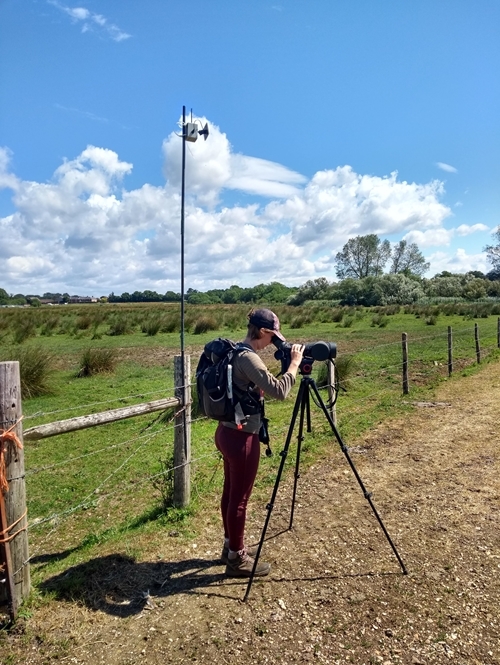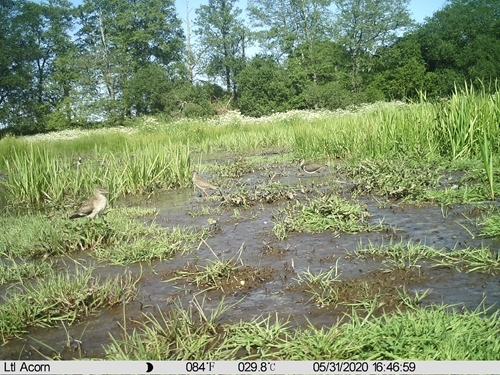By Ryan Burrell
Spring 2020 has been a very different year for members of the GWCT Wetlands team, as it has been for all of us. Thankfully, our team have all remained well and whilst writing this we hope that our readers have managed to remain so too. Spring and summer are often the most exciting times of year for our research team, with every member working on breeding waders in some capacity, be that GPS-tagging Curlew in the New Forest, monitoring Lapwing and Redshank in the Avon Valley or investigating the ecology of breeding Woodcock.
Shortly before the lockdown, the calls of Lapwing and Redshank could be heard throughout the Avon Valley and the anticipation of the pending field season was rising. As the lockdown was imposed, however, and the extent of the pandemic became apparent, the Wetlands team, with guidance from senior managers at GWCT and partners on collaborative projects, suspended fieldwork. The government restrictions, alongside the need to visit multiple sites and closely interact with people on the ground, meant the work was just too risky for both staff and our stakeholders. A hard but necessary decision to make but all hope was not lost.

At GWCT we realise the skills often held by the land and wildlife management community and quick thinking by Wetland ecologists Lizzie Grayshon and Dr Lucy Capstick meant farmers, keepers and landowners were rapidly recruited as deputy research scientists, with maps and lapwing monitoring protocols posted out so monitoring could be conducted around on-going farming and keepering activities. Though a dramatic change of plans, the team were not out for the count, with the submission of the LIFE Waders for Real project pending, the Wetlands and Predation teams quickly switched back to report writing mode, submitting over 20 reports, protocols and papers as outcomes of the project to the EU. LIFE Waders for Real has been a fantastic project, achieving positive outcomes for breeding wader recovery and providing fascinating insights on the behaviour of foxes in wet grasslands.
After the virus peak, with the relaxation in restrictions and on a short return from furlough, Lizzie Grayshon was able to return to the Avon Valley late in the breeding season to record the presence of fledged juveniles and outcomes of late Redshank and Lapwing breeding attempts. For those involved in dairy farming, you can imagine what releasing a wetland ecologist back into the meadows of the Avon Valley was like; the image of cows being let out to pasture from the winter sheds is a good analogy. In the hope of increasing our knowledge from a snapshot of surveys, Lizzie deployed trail cameras in key wader foraging areas, from which she was able to pick up age estimates for several Redshank and Lapwing broods which are notoriously difficult to observe on our sites late in the season.

In 2019, we fitted 20 breeding Lapwing with GPS tags across the Avon Valley (Hampshire), Norfolk Estate (Sussex) and GWCT Scottish Demonstration Farm at Auchnerran (Aberdeenshire). The objective was to gain an understanding of where breeding birds from these sites spend the winter and the pressures they may face during this period. Unlike the tags deployed on Woodcock and Curlew, the smaller size of a Lapwing meant these tags had to be very light and so a mobile base-station needs to be used to download the data when the birds return to breed.
Again, plans for gathering these data in 2020 had to change, but with support from gamekeepers, farmers and students on our sites and the kind loan of further equipment by Natural England we were able to deploy base-stations across all sites. Amazingly, in a year with very limited field access with have managed to gather data from half of the tagged individuals and deploy an additional tag in the Avon Valley.
Now, moving from one of our best-known waders to one of our most elusive, surveys for the national annual roding Woodcock survey, mainly conducted by volunteers were suspended during the Covid-19 peak. Roding surveys are conducted during May and June each year, meaning many first visits were missed but the improved situation has allowed many later visits to be conducted. Again, we are hugely thankful to all the volunteers who take part in this survey. The safety of our staff and volunteers are paramount, but being able to safely prevent a complete break in data collection on this long-term monitoring project is valuable. Our satellite-tagged Woodcock have continued to transmit from their breeding grounds, so keep an eye on www.woodcockwatch.com for the first signs of wintering movements by our birds.
Spring 2020 has been difficult for our three new PhD students, with only late fieldwork on our breeding Curlew project being able to occur. Thankfully, we were able to deploy another GPS tag on a breeding adult Curlew which will transmit data for 2-3 years to come adding to our sample of birds tagged in previous years. These tags have already provided fascinating data on local site use and breeding season movements and will help us to make recommendations for Curlew conservation management as the PhD project progresses. Curlew and Oystercatchers tagged as part of our on-going wintering Oystercatcher and Curlew studies have continued to transmit data from their breeding grounds providing our team with lots of data to analyse when they return to the office later this year.
As the GWCT returns to the new normal, the exciting results of the LIFE Waders for Real project and our new tracking studies will come to light so keep your eyes out for future updates.